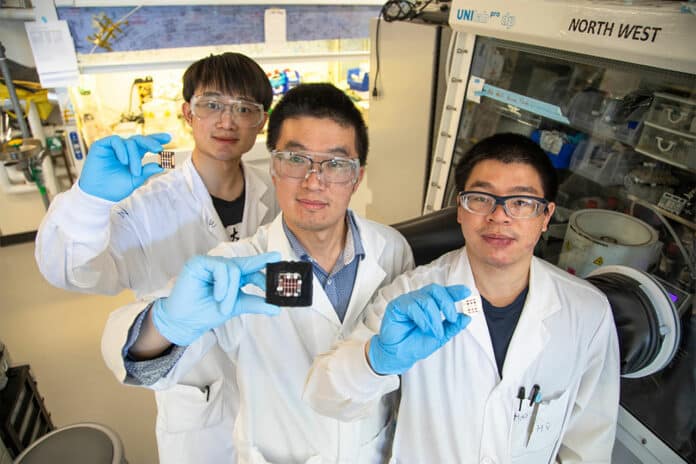Researchers from the University of Toronto have created a triple-junction perovskite solar cell with record efficiency by overcoming a key limitation of previous designs. The prototype represents a significant advance in the development of low-cost alternatives to silicon-based solar cells, which are the current industry standard.
“In addition to lower manufacturing cost, perovskites offer us the ability to stack multiple layers of light-absorbing materials on top of each other, and even on top of traditional silicon cells,” says Professor Ted Sargent, who recently joined Northwestern University but maintained his lab at U of T’s Faculty of Applied Science & Engineering. “In this work, we used rational design to address a critical challenge that can arise in this multi-layered paradigm, improving both efficiency and durability.”
Solar cells are typically made from a single wafer of ultra-pure silicon, which is energy-intensive to produce. By contrast, perovskite solar cells are made using polycrystalline films coated onto surfaces with low-cost solution-processing techniques similar to those used in the printing industry. By varying the composition of the perovskite crystals within these films, each layer can be “tuned” to absorb different wavelengths of light, making efficient use of the entire solar spectrum. This is not possible with silicon, which always absorbs the same wavelengths.
“Multi-layered cells are typically designed so that the top layer with wide-bandgap perovskites absorbs the most energetic photons, meaning high-frequency light with short wavelengths, toward the violet end of the spectrum,” says post-doctoral researcher Zaiwei Wang, one of four co-lead authors on the new paper. “The next layer will absorb medium wavelengths, and the bottom one will absorb longer wavelengths. But it’s in the top layer that we get the challenge of light-induced phase separation.”
Researchers used a type of perovskite material known as ABX3, which is made from a mix of different substances – including cesium, lead, tin, iodine, bromine, and some small organic molecules. In particular, the top layer is composed of mixed halide perovskites, which have a high proportion of bromine and iodine.
In light-induced phase separation of these mixed perovskites, the bombardment of high-frequency photons causes the phases richer in bromine to get separated from those rich in iodine. This leads to an increase in defects and a decrease in overall performance, researchers say.
To solve this problem, the research team used detailed computer models to simulate the effect of altering the composition of the crystals. They suggested two changes – removing the organic molecules for an all-inorganic perovskite structure and introducing the element rubidium.
“Our rubidium/cesium mixed inorganic perovskites show better light stability than [other] perovskite materials, including cesium-based inorganic perovskites and widely used organic-inorganic hybrid perovskites with similar band gaps,” says Tong Zhu, another post-doctoral researcher, and co-lead author.
Researchers then designed and built a triple-junction cell with this composition. They measured its efficiency at 24.3% with an open-circuit voltage of 3.21 volts. They also sent it to be independently certified by the National Renewable Energy Laboratory, which measured a quasi-steady-state efficiency of 23.3%.
Moreover, they say their perovskite solar cell design maintained 80% of its initial efficiency even after 420 hours of operation. Although further improvements to the performance will be needed before perovskite solar cells can compete with silicon in commercial applications, the latest study demonstrates a path forward.
Journal reference:
- Zaiwei Wang, Lewei Zeng, Tong Zhu, Hao Chen, Bin Chen, Dominik J. Kubicki, Adam Balvanz, Chongwen Li, Aidan Maxwell, Esma Ugur, Roberto dos Reis, Matthew Cheng, Guang Yang, Biwas Subedi, Deying Luo, Juntao Hu, Junke Wang, Sam Teale, Suhas Mahesh, Sasa Wang, Shuangyan Hu, Euidae Jung, Mingyang Wei, So Min Park, Edward Sargent. Suppressed phase segregation for triple-junction perovskite solar cells. Nature, 2023; DOI: 10.1038/s41586-023-06006-7
